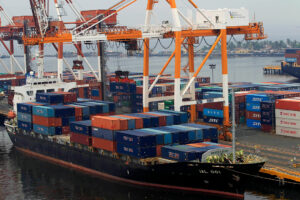THE BANGKO SENTRAL ng Pilipinas (BSP) revised its balance of payments (BoP) forecasts for this year and 2026 amid heightened global uncertainty.
In a statement, the BSP said the overall BoP position is projected to end 2025 at a $6.3-billion deficit or -1.3% of gross domestic product (GDP), wider than the previous forecast of a $4-billion deficit or -0.8% of GDP.
For 2026, the central bank expects the BoP deficit to shrink to $2.8 billion or -0.5% of GDP from the previous projection of $4.3 billion or -0.8% of GDP.
“This outlook reflects a continued current account shortfall and moderating financial flows. While the domestic economy benefits from steady growth, low inflation, and ongoing structural reforms, these are offset by global trade uncertainty, heightened geopolitical risks, and weakened investor confidence,” the BSP said.
Latest BSP data showed the country’s BoP stood at a $5.8-billion deficit in the January-to-May period, a reversal from a $1.6-billion surplus in January to May 2024.
Meanwhile, the BSP also adjusted the forecasts for the country’s current account for this year and 2026.
This year’s current account deficit is now expected to narrow to $16.3 billion or -3.3% of GDP, a downgrade from the previous projection of a $19.8-billion deficit or -3.9% of GDP.
For 2026, the current account deficit is projected to further shrink to $13.6 billion or -2.5% of GDP, smaller than the previously projected $21.2 billion or -3.9% of GDP.
“The current account is expected to remain in deficit at around 3% of GDP, indicating a gap in savings over investment amid global uncertainties. As a result, external financing remains necessary to support the country’s infrastructure-led, investment-driven growth strategy,” the BSP said.
The BSP now expects goods exports to contract by 1% this year from the previous forecast of 1% growth. Goods exports are projected to grow by 2% in 2026.
“Goods exports continue to face headwinds from global trade uncertainty, lagging competitiveness, and constraints in the semiconductor industry,” the central bank said.
The BSP also trimmed the goods imports forecast to 1% this year from 4% previously. For 2026, goods imports are projected to grow by 2% from 4% previously.
“Meanwhile, stable domestic demand and infrastructure spending support the growth in imports, but import value is tempered by declining global commodity prices, particularly, for oil,” it said.
Services trade “remains broadly resilient” but the central bank warned that downside risks persist.
The BSP trimmed the growth forecast for services exports to 6% this year from 8% previously. It retained the 8% services exports growth projection for 2026.
The 5% growth forecast for business process outsourcing (BPO) receipts was retained for this year and for 2026.
“Outsourcing revenues are supported by stable demand for contact center services, yet they confront uncertainties due to US job reshoring initiatives and local talent shortages,” the BSP said.
Tourism receipts are projected to grow by 10% this year from 11% previously. For 2026, tourism receipts are expected to expand by 11% from 12% previously.
On the other hand, the BSP also trimmed its services imports growth forecast to 6% this year from 14% previously. It also lowered the growth projection for next year to 7% from 12% previously.
The central bank kept its cash remittance growth projection to 2.8% this year and 3% for 2026.
“Steady remittance flows continue to provide a buffer against trade deficit, supported by strong labor demand for Filipino workers in key sectors as well as by the aging populations in host countries,” the BSP said.
However, emerging protectionist policies in some host countries present emerging risks, it added.
Meanwhile, the BSP said foreign investment inflows are expected to “remain positive but subdued as policy uncertainty and the global slowdown weigh on investor sentiment.”
Financial account outflows could reach $13 billion this year, lower than the earlier forecast of $16.2 billion. For 2026, the outflows are seen to reach $13.2 billion, smaller than the previous projection of $17.8 billion.
The BSP now expects foreign direct investments (FDI) to end the year at a net inflow of $7.5 billion, smaller than the $9-billion projection in March. For 2026, FDI net inflows are expected to hit $8 billion, lower than the previous projection of $9 billion.
Meanwhile, foreign portfolio investments (FPI) are expected to end at a $6.8-billion net inflow this year, higher than the $3.9-billion earlier forecast.
For 2026, net inflows of foreign portfolio investments are expected to reach $5 billion, lower than the $4.1-billion previous projection.
“The moderation in trade and investment flows limits the country’s scope to build up foreign exchange reserves. Nonetheless, reserves are expected to remain ample, providing sufficient liquidity to cushion the economy against external headwinds,” the BSP said.
The central bank also lowered its 2025 gross international reserves (GIR) forecast to $104 billion from $105 billion previously. It kept the GIR forecast at $105 billion for 2026.
Rizal Commercial Banking Corp. Chief Economist Michael L. Ricafort said the weaker BoP outlook can be attributed to a global economic slowdown due to the US tariff policy and geopolitical risks.
“These external risk factors could also slow down the growth in the country’s structural US dollar inflows such as OFW (overseas Filipino worker) remittances, BPO revenues, foreign tourism receipts,” he said in a Viber message.
Mr. Ricafort said these external challenges may result in slower global investments, exports, employment, increased volatility in global crude oil and other global commodity prices. — Aubrey Rose A. Inosante
